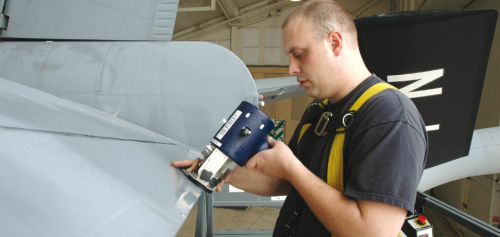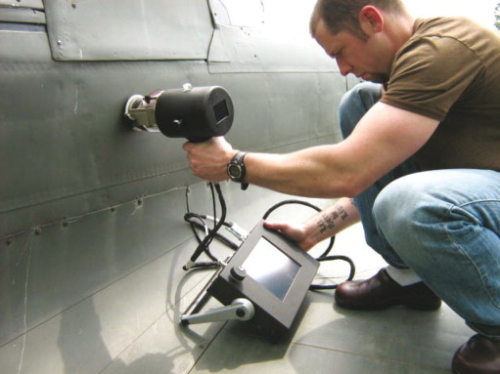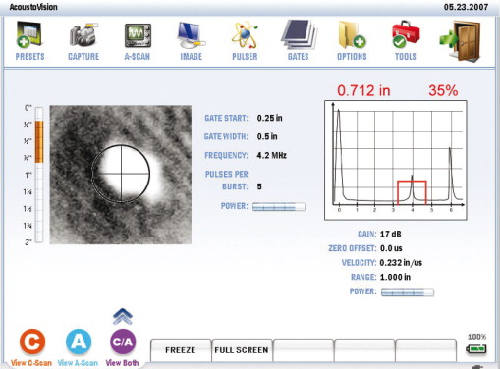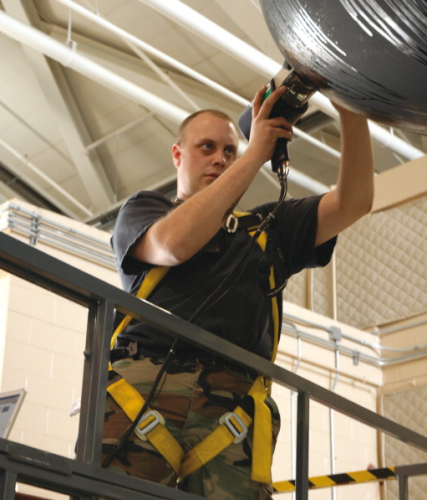



Ultrasound is arguably one of the best non-destructive methods for finding internal defects within composites. However, current single-point ultrasonics testing is a slow, laborious process that requires a highly trained specialist. Accidental impact damage cannot easily be found and quantified without complicated equipment which requires extensive training. A quick and easy inspection of aircraft composites in the field is badly needed. Through an ongoing project with Boeing, Imperium has developed a novel ultrasound camera for in-service non-destructive testing (NDT) of composites that alleviates these limitations. It is called the Acoustocam (Figure 1).
The ultrasound camera is based on a patented imaging array that generates real time ultrasound images over an area, similar to a conventional camcorder. A non-specialised technician can easily understand the resulting imagery. Imperium is the sole provider of the Acoustocam, which is easier to understand and use than anything currently on the market.
Each frame, presented at TV rates, presents image over an area. A handheld probe is placed against the target under study and real time sub-surface imagery appears on a display. The system is portable and requires little training. Compared to other NDT methods, the advantages of this technique include rapid results, and image-based delamination assessment and crack detection. These features have led to Boeing's adoption of the Acoustocam.
The camera
The Acoustocam is a field portable, simple handheld ultrasound imaging camera, requiring one day of training. The user is not necessarily a trained nondestructive inspection (NDI) technician. The device is designed to be a first line of defence in finding internal composite damage in aircraft structures. Imperium have been teamed with Bell Helicopter and Boeing on much of this work.
The Acoustocam is essentially a camcorder for ultrasound. The quality of the information imparted by this real time video image is far superior to that of conventional A-scan amplitude data or phased array ultrasonics. The images are easier to read and have much greater spatial resolution. Integration of ultrasound energy over the time period of a video frame results in high signal to noise and sensitivity. This in turn allows reducing the device to a simple, portable, low cost tool that any inspector can use. The system uses a large unfocused transducer to ‘illuminate’ the target. The resulting scattered wave is collected by an acoustic lens set onto a novel imaging array.
Industry needs
As composites become more prevalent in aircraft platforms, the need to be able to inspect these structures is vital. Presently, there is no easy to use, simple device for maintenance personnel to be assured that there is no sub-surface damage in composites. The incidence of failure of aircraft is rare, but clearly even a single failure is unacceptable. The current inspection systems provide a high confidence in the detection of damage but have several limitations. The inspection process is slow and labour intensive, taking many hours to perform the inspection. The resolution of the current systems is course, making analysis of the data difficult. As a result, testing is almost exclusively done by tap testing or simply by visual inspection. If NDT tools are used, the most common is a standard UT probe providing pulse echo ultrasonic waveform data. The returning echo from the original ultrasonic pulse is digitised and processed electronically to provide information regarding the composite. Potential problems with the structure are identified with loss of back-wall echo and can be further characterised by reviewing the entire ultrasonic waveform data. This inspection is performed several times at the factory and during in-service usage.
Advanced composite materials being used on newer platforms such as the V-22 and Joint Strike Fighter aircraft are obviously subjected to harsh conditions. The most prevalent scenario involves the material being impacted during the course of normal use. However, there is no reliable, simple device for large area composite inspection. This damage can often not be seen at all from the surface, making visual detection nearly impossible. This damage can have catastrophic results if not found before flight.
Any damage that occurs at the operational level requires quick response. Similarly, the integrity of composite patches must be quickly evaluated. Practical matters must also be considered. An aircraft carrier has limited repair capability and space is a premium. Fast and effective decisions are a must.
The need to find these defects must be balanced with aircraft downtime and overall maintenance costs. The ideal solution for composite damage is a quick, portable device which can give the inspector real time, easy-to-interpret data without any disassembly.
The Acoustocam system is particularly suitable to address these needs. Specifically, the system has the following features:
- can be used by non-specialists;
- quick simple alternative to tap testing;
- designed specifically for the evaluation of hidden structures and materials;
- proven in its capability to detect materials defects, composite delaminations, thermal and mechanical damage;
- small, light weight, and low power;
- designed for real-time in-situ NDE;
- low cost;
- can work on flat or curved parts;
- no disassembly or time consuming setup needed;
- provides real time, simple feedback;
- requires no extensive training; and
- robust design capable of surviving hostile aerospace environments.
The sub-surface imagery generated by the C-scan ultrasound laboratory system is striking for its video appearance. The imagery appears qualitatively similar to that obtained with visible light cameras. In summary, the advantageous features of this imaging system are:
- high-resolution, rapid imaging of large areas of hidden surfaces;
- large area;
- high digital data rate (30 full image planes per second);
- standard video presentation; and
- images are easy to interpret with little training (one day).
The camera head is connected to a base control unit which contains electronics and a single board computer (SBC) to control the camera and chip. The control unit is controlled by a graphical user interface with a touchscreen. A typical system is shown in Figure 2. The current camera head weighs 4 lbs and the control unit weighs 7 lbs.
To operate, the user places the probe against the target. A small amount of ultrasound gel is placed on the area to be imaged to allow the ultrasound to propagate from the probe into the target and it begins imaging immediately. An image capture button on the camera probe would store up to hundreds of images before a download would be required. One future consideration is to put a wireless transmitter in the control unit so that images could be sent to a base station or another user in real time.
The software on the touch screen which controls the camera and displays video is shown in Figure 3. The interface shows both the C-scan and the A-scan. It shows the C-scan on the left with a crosshairs. The right side shows a full waveform which is the A-scan at the C-scan crosshairs. The A-scan has full flaw detector capabilities (material velocities, gates, alarms, etc).
Results
Imperium and several industry partners have investigated the use of the ultrasound technology for composite damage. For a period of three months, we used the Acoustocam for the inspection of barely visible impact damage (BVID) for Boeing. Dr Gary Georgeson of Boeing provided samples for the study. The ultrasound camera was reviewed for both detection capability as well as ease of use.
Other results included the investigation of composite standards.
The system was also studied for finding defects along a radius or curved surface.
Since porosity is difficult to simulate, the system was evaluated with a real life example resulting from positive air pressure under the bag during cure of a production part. The porous areas were clearly visible.
Dr Richard Bossi of Bossi writes that the ultrasound camera: “has the characteristics necessary to be successful …”, and “… In particular it has been shown to be very easy to use and fast ….”
Imperium Inc has been developing and manufacturing advanced ultrasound imaging systems since 1996. The company was founded by Dr Marvin E. Lasser, the Chief Scientist of the US Army and former Director of Research for Ford (Philco Division). Current users of the company's products include companies such as Boeing, Airbus, Bell Helicopter, US Army, US Navy, US Air Force, US Army, and NASA. Applications of the technology can be found in industrial, medical, subsea and biometric settings. The technology is protected by several granted and pending patents. |
Based on these results, Boeing has endorsed this programme. Gary Georgeson, Boeing Phantom Works, Seattle, Washington, has expressed the following support: “I now believe your device offers the potential for a non-specialised inspector to quickly and easily find defects with minimal training.”
The quality of these results has led to a programme funded by Boeing to transition the camera to airport loading gates for quick inspection of composites on commercial aircraft, for internal defect detection by a non-specialised technician. During early 2008, Boeing decided to write a new procedure for the Imperium ultrasound camera into their inspection procedures. The images are monitored in real time via a local wireless network by an expert often thousands of miles away.
The project, which has been developed in collaboration with Boeing engineers, will allow maintenance personnel to use Imperium's Acoustocam to quickly survey damage without having to bring in harder to set up, conventional ultrasound equipment – all from remote locations.
The Acoustocam is a hand-held device that may be used as part of quick survey of suspected damage areas. The device shows subsurface defects that cannot be seen visually. The user simply places a probe against the aircraft structure and with proper equipment setup; sub-surface defects appear on a handheld monitor in real time. The advantage of the remote operator interface is that the expert NDE operator may be remotely situated.
“We believe remote expert monitoring can benefit the inspection process in countless ways for manufacturers of composite structures,” said Bob Lasser, President of Imperium. “We plan to roll out the programme nationwide in 2009.”
US Air Force
The USAF Air Mobility Battlelab (AMB), Fort Dix, New Jersey, recently conducted a demonstration utilising an Imperium ultrasonic camera to determine the suitability of ultrasonic technology in improving aircraft inspections. The demonstration was completed at McGuire Air Force Base (AFB) on a KC-135E aerial refuelling tanker aircraft, Grand Forks AFB on a KC-135R, and Mountain Home AFB on a F-15C fighter aircraft. They have decided to modify their testing procedures to include the Acoustocam during maintenance.
Figure 4 shows the camera in use by a crew chief at the 108th Air Refueling Wing at McGuire AFB, New Jersey, part of the New Jersey Air National Guard. The inspector, MSgt. Ken Challender, did not have any nondestructive testing experience before utilising the camera. The training needed to get him using the system required about three hours.
The reaction from all crew chiefs who used the system was that the camera saved a significant amount of time that is now being spent on tap testing. Furthermore, tap testing is not reliable or repeatable and is fraught with a high number of false positives. All of these sites are currently utilising the device. As the device has gained more industry acceptance, it has become an invaluable tool for simple detection of internal composite damage.


